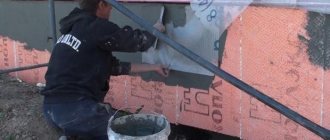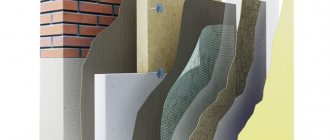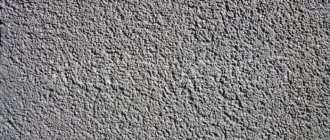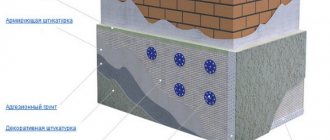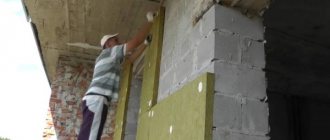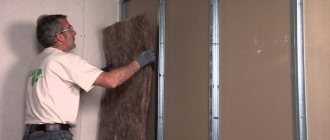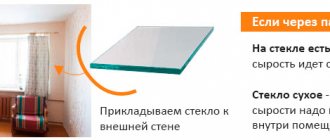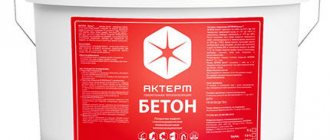The problem of damp corners and walls often worries both residents of high-rise buildings and owners of private houses. Due to the fact that the corner of the room is damp, the walls begin to darken, the wallpaper peels off, mold appears, and the air in the room becomes heavy. Plus, during the cold season, the temperature in the rooms drops, windows are opened less often to ventilate the room, a lot of precipitation falls, and the walls themselves are not dried by the sun's rays.
Damp corners and walls are a fairly serious problem that should be addressed immediately. Damp indoors can cause various diseases and also become a gathering place for fungi and mites.
Therefore, the question of why the corners in the house become damp worries many.
Causes of dampness
The sources of dampness in the corners of rooms can be obvious or hidden. Some are easy to spot, while others will require searching. However, all the reasons why corners in the house are constantly damp are divided into two subcategories - internal (poor ventilation, insufficient heating) and external (increased thermal conductivity of the wall, penetration of water from outside, etc.).
Damp and blackened corner
Dampness often appears in the corners of a room in the following cases:
- the wall is “leaking” (water can enter through cracks in the wall from the attic, drainpipes or eaves);
- the wall freezes (the corners are “crying” because a “cold” bridge has formed due to the increased thermal conductivity of the walls);
- heating in the room is insufficient;
- there is no ventilation or it is ineffective;
- fungus has formed on the walls;
- the foundation of the house is poorly waterproofed;
- there is a lot of washing and drying in the house;
- there are no hoods in the kitchen and bathroom;
- a void has formed in the seams that are not filled with mortar;
- external walls are too thin;
- voids have formed in the floor slabs;
- cooling occurs through metal beams or reinforced concrete structures;
- there is too much water and moisture in the basements;
- balcony slabs are poorly sealed into the wall;
- Condensation appears on ventilation pipes due to improper vapor barrier.
Eliminating dampness in corners
Attentive owners will always notice damp corners in time and determine the cause of the appearance of phlegm.
After identifying the culprit of the problem, you can begin to eliminate it:
- If the wall freezes, you need to take measures to insulate it. The most effective way is to insulate the walls from the outside. It will not only reduce dampness, but also reduce heat loss. This is done either with mineral wool or polystyrene foam. However, for owners of apartments in high-rise buildings, such insulation is quite a troublesome task. If problems arise with external insulation, you can insulate the wall inside the room.
When applying insulation from the inside, thermal calculations should be made to avoid the appearance of condensation and moistening of the insulation material, as a result of which its insulating properties are lost.
- To make the correct calculations, the humidity in the room, climate, degree of thermal conductivity of the wall, etc. are taken into account, so in such cases, expert advice is simply necessary.
- If the heating system is inefficient, additional sources of thermal energy should be used. This could be an electric fireplace, a stationary battery, a radiator or other alternative heaters, which are recommended to be installed in places where there is the most dampness.
- If condensation appears due to excessive tightness of the room after installing plastic windows, the room should be ventilated more often.
- If the walls are not thick enough, it is recommended, if possible, to line the outside of the building with an additional ball of brick or apply insulation under the plaster. You can insulate the walls from the inside with slab insulation (foam plastic, mineral wool), placed on the frame with 5 cm wide walls to fill it with expanded clay. This building material will absorb moisture from a damp wall and prevent the spread of mold.
- Ventilation can be improved by installing an additional hood, and at the bottom of the door at the entrance to a separate room you can make a gap to regulate the air. Ventilation should also be improved in the bathroom and kitchen, which are most often sources of dampness.
- If there is a basement underneath the home, moisture can penetrate through microcracks in the floor, causing the walls to become damp. To eliminate this problem, the floor is treated with an antifungal agent, a moisture-resistant base is laid on it, and all cracks are sealed with sealant.
- If the cause of damp corners is fungus and mold that has appeared in the wall on the plaster, then all affected areas are treated with antifungal solutions, plastered again, if necessary, with a high-quality mixture, and only after that new wallpaper is glued.
- If balcony slabs are installed poorly, moisture penetrates into the seams, so the joints between the slab and the wall should be sealed so that there are no leaks that lead to damp spots.
- When caulking seams in external walls, care should be taken to ensure that closed and open joints provide air protection, and that the latter are well protected from moisture.
Why do the walls get damp?
Wet walls are a disaster for owners. First, the wallpaper peels off, the plaster is destroyed, and mold starts to grow. It is difficult to fight with it, its presence has a bad effect on health. There are several reasons why walls get wet.
Recent renovation
Partitions often become wet after recent renovation work. This is the most harmless reason. There is no need to eliminate it; it disappears on its own over time. The slight humidity inside the apartment after renovation is easy to explain.
The cement mortar used contains water. Poor ventilation, plus damp weather, affects the rate of moisture evaporation. Therefore, worries about humidity are unfounded.

Moisture seeps in from above
External moisture
The walls of apartments on the upper floors get wet as a result of poor quality of the system for collecting and draining water from the roof and poor treatment of seams with waterproofing material. Moisture seeps through microscopic cracks.
Panel buildings are also vulnerable. Violation of construction technology leads to depressurization of the seams between the panels.
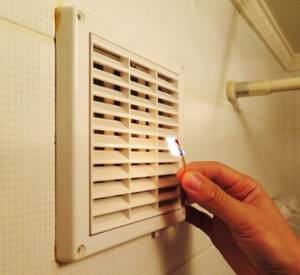
Ventilation check
Insufficient ventilation
The reason for damp walls in rooms with high humidity is poor ventilation. We're talking about the bathroom and kitchen. The performance of the ventilation is determined by opening the window and placing a piece of paper on the vent grille. If the leaf sticks to the ventilation grille, air exchange is not impaired. If paper falls, the ventilation is not working and requires cleaning.
High indoor humidity
Moist fumes penetrate from the basement due to poor waterproofing. Brick has different moisture resistance. Silicate has the lowest performance.
The problem occurs in multi-apartment buildings with basements and poor waterproofing. Sections of the walls near the floor are damp.
Excess humidity appears after installing sealed plastic windows. Periodic ventilation of the room eliminates the problem and removes condensation on the windows.
Wall freezing
Freezing occurs due to poor thermal insulation. It is reduced by insufficient wall thickness, opening of interpanel seams, and cracks.
The corners on the upper floors of the building are damp
In private houses or on the highest floors, the walls are often damp due to the attic.
This happens in the following cases:
- the corners turn gray due to violations in the insulation of the attic; dampness and black spots appear most of all in places where the attic floor adjoins the external walls;
- the attic space is poorly ventilated (few ventilation holes, no through ventilation); with good ventilation in the attic, the same temperature is maintained over the entire surface of the roof in the autumn-winter season.
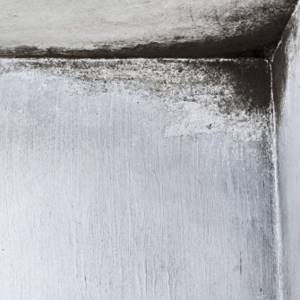
Dampness in corners on the top floor
Preventing the appearance of dampness
Following certain rules will help reduce dampness to a minimum and prevent its occurrence in the future.
- Laundry should be dried outside living rooms or with the hood turned on for air removal.
- When cooking, pots and pans should be covered with lids to prevent steam from escaping.
- In the bathroom, where the highest concentration of humidity is, as well as in the kitchen, hoods and ventilation openings should be regularly cleaned to remove excess debris, and these rooms should also be ventilated daily.
- In a private house, you can insulate the attic and also cover the walls with a waterproofing material, preferably with pores.
- All flammable substances that form a lot of moisture, in particular paraffin, should be used extremely rarely indoors.
- All rooms in the house should be ventilated daily.
- Correct errors in the heating system in a timely manner.
- Use a dehumidifier to reduce humidity. This household appliance can easily cope with the problem of dampness, and its compactness allows you to move the dehumidifier from room to room.
Wet wall in an apartment - where to go?
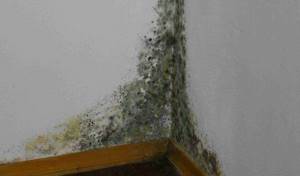
The first step is to find out why there is a wet wall in the apartment. For this purpose, residents should contact their management company and call a specialist who will inspect the “problem” area and draw up an appropriate report.
This document is drawn up in the presence of the citizen who called the master and at least two witnesses. In the future, it can be used to appeal to government authorities.
If the reason for the appearance of moisture on the walls is not related to the operation of the management system, the owner of the residential premises will have to correct the problem.
If the foreman determines that a wet wall is a consequence of the management company’s failure to fulfill its functions, the citizen has the right to send a complaint or claim to the organization’s office.
As soon as possible, the Criminal Code undertakes to give a written response to the applicant and take measures to correct the situation. The company's refusal must also be in writing.
Unlawful actions or inaction of the Criminal Code can be appealed to higher authorities:
- housing inspection;
- Rospotrebnadzor;
- prosecutors;
- local administration.
A citizen must send a well-written complaint to the above authorities. The law does not prohibit simultaneously applying to several authorities. As a last resort, the tenant is recommended to file a claim against the actions of the Criminal Code in court.
Reducing humidity
If walls often get wet in interior rooms with high moisture (bathhouse, bathroom), then the problem is most likely in the ventilation system. Therefore, first of all, you should check the ventilation openings for the presence of unnecessary objects that may interfere with air circulation.
It’s easy to check how clogged the ventilation channels are: hold a burning candle to the vent and watch how the flame reacts: if it reaches towards the grate, then the channels are not clogged and there is a draft. When there is no flame response to ventilation, additional devices need to be installed in order to establish air circulation.
Some nuances of sealing joints
If the tightness of the seams is broken and cracks appear in the walls, the corners in the room begin to become damp. In this state of affairs, there is only one way out: the waterproofing of the joints between the panels needs to be repaired, and microcracks in the walls need to be repaired.
After high-quality sealing, the walls should not gain moisture. They can become damp and leak only when the technology for sealing the seams is broken.
The main mistakes are applying sealant without prior repair or using a low-quality sealant.
This should also be taken into account: if waterproofing of joints is carried out in one apartment, and not in the whole house, then the problem of dampness will not disappear. Moisture will penetrate into poorly sealed seams in an apartment on the floor above or on the technical floor, so although more slowly, it will find its way into the desired room.
Inspection using a thermal imager
In concrete structures that are actively used today, there is a high level of protection against through freezing. Thanks to the use of modern equipment, finding areas where heat loss occurs will not be a big problem. For this purpose, thermal imagers are used, which in just a few seconds can identify areas on the wall with poor thermal insulation.
Thanks to the use of such a device, specialists can quickly find places that need additional insulation. In most cases, we are talking about seams in which cracks have formed due to certain circumstances. Using a thermal imager, you can detect such areas of the wall and begin to correct the problem.
If, after sealing the seams, there is still high humidity in the room, do not give up, you can still fix it. Most likely the walls remain damp due to poor quality thermal insulation. In this case, you can order from the craftsmen not only the sealing of interpanel seams, but also the application of a new ball of waterproofing materials. Just dial our number and very soon real professionals in this field will get down to business. We guarantee the high quality of the work performed, and the prices for services will definitely pleasantly surprise you.
If the joints open and the water barrier tape moves, you need to start repairing the seams
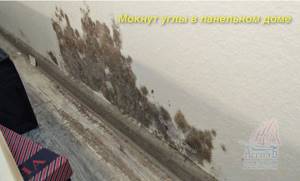
Foundation waterproofing
It happens that dampness in the house is caused by the fact that the foundation is poorly insulated. If its waterproofing is insufficient, groundwater when raised above 1.5 m can penetrate into the walls. In this case, they will get wet, mold will appear under the baseboard and in the corners, the plaster will begin to fall off, and the wallpaper will deteriorate. However, if horizontal waterproofing of the foundation is done correctly, it can prevent the penetration of groundwater.
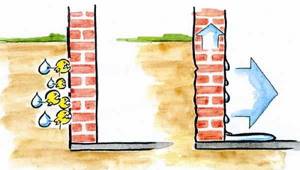
Why does the foundation get wet?
Condensation after installing new windows
It happens that pockets of dampness appear in the corners of an apartment after replacing ordinary windows with plastic ones. The installed windows are very airtight; they tightly close the openings, as a result of which the ventilation of the room deteriorates. You can avoid damp walls in such cases if you know what to do.
Ventilation is often sufficient to exchange air in a room. However, if this is not enough, you can improve ventilation by installing an additional fan on the vent. Then the humidity in the room will decrease, and there will be no condensation of moisture on cold walls, in particular in corners where air exchange is reduced.
The problem of damp corners often becomes a concern during the cold season. Many people don’t even notice damp walls at first, but when the moisture turns into mold, the problem should be taken seriously. Constant dampness in the room causes fungi, mites and centipedes to multiply, and residents may develop various diseases, shortness of breath, cough, and allergic reactions.
Excessive indoor humidity
The simplest reason, in terms of elimination, is high humidity in the apartment. It is possible that the appearance of pockets of dampness was preceded by the replacement of windows in the room. New windows closed the openings more hermetically and worsened the ventilation of the room. In some cases, in order to avoid dampening the walls of the apartment, it is enough just to ventilate the room more often.
If this is not enough, or the problem occurs in a room with potentially high humidity, for example, a kitchen, then you can try to improve the quality of ventilation. To do this, you can put a fan on the vent. Thus, ventilation will turn from natural into forced supply and exhaust with greater productivity.
Video: how to get rid of dampness in a house or apartment
The fight against excess moisture in a living space must begin immediately. This process is quite labor-intensive and sometimes requires money. However, with an accurate determination of the root cause of the increase in humidity and the correct choice of effective ways to combat dampness, you can forget about wet corners forever. And if necessary, new renovations in the apartment will refresh the walls and please everyone.
The monolithic brick house consists of several sections standing close to each other. In winter, the wall that faces the adjacent section is wet in the corners. What could be the problem and how can it be fixed?
yes this can be fixed. all because of the unscrupulous builders who built the house. The reason is simple (they forgot to insert insulation) to fix this, rake out the corner, insert insulation, plaster, hang wallpaper and your problem is solved!
This is condensation. It is formed due to the release of heat (from the apartment) to the street. It is advisable to conduct an examination for heat loss. It is possible to renovate both the apartment and the street side. Need details.
gets wet due to the difference in temperature (inside-outside) and humidity in the room. that is, if the air temperature in your apartment is 25 degrees, with an air humidity of 50%, condensation (dew point) will form on sections of the walls whose temperature is +13.9C. In your case, the freezing of the corners is obvious. You need to contact the management company with your problem; their responsibility is to monitor all seams and connections in the house and maintain their repairs. insist on warm seam technology. If the corners in the room are monolithic, then they need to be additionally insulated. The formation of condensation often leads to the spread of various types of mold. Here's to help you: I. “Rules and standards for the technical operation of the housing stock” (approved by the Post of the State Construction Committee of the Russian Federation dated No. 170): “…..2.6.2. When preparing the housing stock for use in winter, it is necessary to: – eliminate faults: walls, facades, ….. ….. 4.2.1.1. The housing maintenance organization must ensure: – the specified temperature and humidity conditions inside the building; – elimination of damage to walls AS DETECTED, preventing their further development; – heat protection, moisture protection of external walls. ….. 4.2.1.7. The joints of the panels must meet three requirements: – water protection due to sealing mastics in compliance with the technology of their application; – air protection due to sealing gaskets made of poroizol, gernite, vilatherm, tow, resin rope or other materials with a mandatory compression of at least 30 - 50%; – thermal protection due to the installation of insulating packages. In closed type joints, waterproofing is achieved with a sealant; air protection - sealing materials with mandatory compression of 30 - 50%; thermal insulation - with heat packs or “vuts”, the width of which must be at least 300 mm. Butt joints that have leaks MUST BE SEALED on the outside with effective sealing materials (elastic gaskets and mastics) by specialists ASAP (IN SMALL VOLUMES during the period of preparing houses for winter). ….. 4.2.3.1. Local destruction ..... sealing seals of joints of prefabricated buildings must be eliminated AS IDENTIFIED, preventing their further development ..... Appendix No. 7 LIST OF WORKS RELATED TO CURRENT REPAIRS ..... 2. Walls and facades SEALING JOINTS, sealing and restoration of architectural elements ; changing sections of wooden wall cladding, repairing and painting facades. II. MDK “Methodological manual for the maintenance and repair of housing stock” (approved by order of the USSR State Construction Committee in 2004): “….. 2.2. Current repairs of the common property of a residential building are repairs carried out in a planned manner with the aim of restoring the serviceability or performance of a residential building, partially restoring its resource with the replacement or restoration of its components of a limited range established by regulatory and technical documentation. The list of works included in the fee for housing repairs (current repairs) is given in Appendix 2 to this Manual. Appendix 2 LIST OF WORK INCLUDED IN THE FEE FOR HOUSING REPAIRS (current repairs) .....2. Walls and facades: ..... – SEALING JOINTS of elements of prefabricated buildings, sealing potholes and cracks on the surface of blocks and panels;» III. “Methodological recommendations on the financial justification of tariffs for the maintenance and repair of housing stock” (approved by Order of the State Construction Committee of Russia dated December 28, 2000 N 303): “….. 2.2. Determination of standard costs for repairs of structural elements of residential buildings..... 2.2.1. This cost item should reflect the standard costs of carrying out a set of works to maintain in good condition the elements of a residential building, the specified parameters and operating modes of its structures and technical devices: technical inspection, preparation of the housing stock for seasonal operation, MAINTENANCE AND CURRENT REPAIR of structural elements of buildings ( foundations and basements, WALLS,…..). IV. “Methodological recommendations for organizing and carrying out routine repairs of the housing stock of all forms of ownership (order of the State Construction Committee of Russia dated): “….. 2.1. The basis for determining the need for current repairs of the housing stock, establishing or clarifying its volumes are the results of scheduled general technical inspections of residential buildings. 2.1.1. Scheduled general inspections of buildings are carried out twice a year (spring and autumn) within the time limits established by the housing (housing and communal services) management body, depending on local natural and climatic conditions Appendix 4 LIST OF WORK FOR ROUTINE REPAIR OF RESIDENTIAL BUILDINGS 2. Walls and facades .... ..... 2.2. SEALING JOINTS of elements of prefabricated buildings, sealing potholes and cracks on the surface of blocks and panels.”
SEALING INTER-PANEL JOINTS
If it is necessary to work with the interpanel seam from the outside, if a leak is detected, it must be opened above the place where there is an area of high humidity on the wall. Moisture has the ability to seep into the smallest cracks, so this rule should never be neglected. At the same time, it is not always possible to detect an area where seam defects are clearly visible. In such cases, you simply need to lay a new insulating material in the joint, which in the future will serve as protection from moisture.
A leak in the wall can also be caused by the fact that the insulation has simply dried out and crumbled. Microcracks may also form in it. This may be caused by shrinkage of the building or due to the use of materials unsuitable for the existing climate.
Also, the joints of the plates can leak if the welding area is too close to each other or if the insulation is too dense. The problem may also arise due to the use of screed, the outer layer of which hardens after 24 hours, but the moisture inside can persist for more than one month.
The main reasons for freezing corners and walls in a brick house
The photo shows some reasons for the freezing of a house and the appearance of cracks.
The main reason is, of course, the laws of nature, or rather, incorrect construction calculations, where these factors were taken into account incorrectly or with an error. Violation of the rules for dressing brickwork also largely influences the appearance of damp corners in a brick house, as well as the insufficient thickness of the brickwork itself for a given climatic region.
In this context, special attention should be paid to the corners, which are structurally bridges of cold. Of course, even at the construction stage, due attention had to be paid to their thermal insulation. But even if they were insulated, it is not a fact that it was done professionally and with appropriate insulating materials.
It is in corner masonry that improper dressing of seams can play the most important role in the occurrence of this problem.
Some ways to eliminate freezing symptoms
The photo shows the search for the cause of freezing.
You should not immediately take measures to insulate the room - simple insulation, especially from the inside, will not give practically any effect, but will only shift the dew point, and the moisture will condense elsewhere.
For example, cold air will come into contact with warm air indoors. And this will significantly worsen the situation.
Advice. The problem is identified, as a rule, in the cold season, but it must be solved in the warm season, when it is possible to thoroughly dry the house as a whole and problem areas in particular.
The best option:
- sealing seams;
- thermal insulation of the facade;
- thermal insulation of the foundation.
Although thermal insulation of the facade is unlikely to be possible if the facade is lined with decorative or facing bricks. In this case, the only way out is to carry out internal insulation work.
Although their effect is much lower, if they are performed correctly, this will solve the problem associated with freezing of corners and walls.
Insulation and insulation of problematic walls and corners inside the house
The photo shows complete protection of the wall from cold and dampness.
If a problem appears in the house after all the finishing work has been completed, most likely you will have to do the repairs again, since cosmetic measures will not give results.
The following work needs to be done:
- remove wallpaper, plaster;
- unstitch the seams;
- treat seams and walls with antifungal compounds;
- The next serious operation is how to dry a brick house, that is, dry the walls and the room itself . For this, it is best to use heat guns, but household heating devices can also be useful;
- re-fill seams, voids or cracks that have appeared with polyurethane foam, liquid foam compositions, you can use so-called “warm” types of plasters , which contain particles of expanded polystyrene, which have high heat-insulating properties;
- cleaning treated seams and surfaces and preparing them for plastering work;
- performing plaster, most often several layers are required, for the first, again, you can use the same “warm” plasters , but you can also use regular plasters, but with the addition of hydrophobic additives, the instructions detail how to use them;
- Additionally, you can apply a layer of liquid insulation with excellent adhesion characteristics . Outwardly, it resembles paint and is applied with a roller or brush. In addition to its main function, it has both antifungal and anti-corrosion characteristics, which allows this material to be used, for example, for anchoring ventilated facades, significantly eliminating the effect of “cold bridges.”
The floor and wall in a private house are damp
In this case, repairs are useless, since all your attempts will be actively destroyed by the mold that has arisen in the walls.
In what ways can you speed up the drying of walls and ceilings after localizing external leaks?
Washed laundry always dries faster where there is active ventilation and less air humidity. The same principle applies to dampness in the walls. In rooms with damp walls after external leaks, it is necessary to create a mode of active ventilation and lower air humidity. How to create such a mode? In summer, when the weather is hot, it is enough to keep the windows constantly open, creating a draft in the rooms. In all other cases, such a regime will have to be created artificially, using special air dryers.
How long will it take to dry damp walls like this?
It all depends on several factors: what material the walls are made of, how thick they are, and how wet they are. To speed up the drying process of damp walls after localizing external leaks, it is necessary to remove wet wallpaper and old plaster from the walls, which will create an active obstacle to the ventilation of the wall surface.
Is it possible to further intensify the drying of walls and speed up repairs after localizing external leaks?
Yes you can. On the market of modern building materials, there are environmentally friendly capillary active sanitizing heat-insulating plasters of the THERMO series, which perform very important necessary functions - they constantly artificially draw moisture from the walls, drying them and preventing the possibility of the formation of fungus and mold. In addition to the properties described above, the thermal insulating sanitizing plasters of the THERMO series additionally have the following properties: durable, non-flammable, moisture-resistant, inert in aggressive environments, have excellent sound absorption that prevents the occurrence of echoes, as well as high vapor permeability and adhesion to all building materials, including glass In short, by using the sanitizing heat-insulating plaster of the THERMO series in repair work at the stage of incomplete drying of the wall, you do not risk ruining your repair, since thanks to its unique hydrophobic and air-permeable properties, Thermo plaster helps remove moisture from the building structure.
Dampness in the walls of the apartment communicating with the street.
If one wall or several walls of your apartment face the street and these walls are constantly wet, then two reasons for dampness in the walls can be considered - either poor waterproofing of the outer surface of the wall, or insufficient thermal insulation of the wall.
In the first case, to restore the waterproofing of the outer surface of the wall communicating with the street, it is necessary to use special water repellents
.
which create a protective water-repellent coating on the wall surface. The water repellent
is inexpensive, and it is quite simple to apply by spraying it on the wall. The main problem can only arise in the performer of the work, since in most cases such work must be performed at high altitudes.
In the second case, to insulate the wall, it is necessary to decide on which side the wall will be insulated from the outside or from the inside? For external wall insulation, it is necessary to resort to the help of third-party organizations specializing in high-altitude work. This solution to the problem is often unacceptable, since no one wants to pay for expensive work. However, if you still decide to externally insulate the apartment wall, we recommend that you use either Teplomet-Facade
.
or heat-insulating sanitizing plasters of the THERMO series.
Teplomet liquid-ceramic thermal insulation
.
or heat-insulating sanitizing plaster of the THERMO
.
What is the difference between Teplomet and THERMO?
Liquid-ceramic thermal insulation Teplomet
It is most convenient to apply when the wall is in its driest state.
This usually happens in the summer. Teplomet
liquid thermal insulation is extremely simple and you can handle this work yourself.
You can
more about the properties of Teplomet here...
As for the thermal insulating sanitizing plaster of the THERMO series,
then you can’t do without it if your wall is in a damp state at the time of starting work on insulation from the inside of the apartment.
Thanks to its unique hydrophobic and breathable properties, Thermo
helps remove moisture from damp walls while insulating them.
However, the technology for applying thermal insulating sanitizing plaster of the THERMO
is more complex than the liquid thermal insulation technology
Teplomet
.
And here you will have to resort to the help of a qualified specialist, which will certainly affect the cost of work on insulating the wall from inside the apartment. more about the properties of THERMO
and the technology of its application
here...
Proper insulation of the facade - warmth and comfort in a brick house
Photo of facade insulation.
Basic thermal insulation work should be carried out to protect the façade. And then, only if the house is not lined or the owner is ready to change its appearance.
First of all, it is necessary to study the consistency of the seams and dressings of the brickwork. If there are defects, they are sometimes embroidered and then filled with heat-insulating types of plasters.
One of the most effective methods is the construction of a ventilated facade, suitable for almost any latitude, except that its use in very harsh winters is sometimes called into question, although it shows quite high efficiency in this case.
Various thermal panels, in particular polystyrene ones, have good thermal insulation and performance properties, and at the same time their price is quite affordable.
If the facade work has not yet been carried out and the house is being prepared for finishing, for example, with decorative bricks, even if there are no problems with freezing and the wall of the brick house does not get wet, appropriate thermal insulation work is still required so that this does not happen later problem and additional costs.
Freezing due to cracks, reasons for their appearance
Photo of a crack in the wall.
Owners of brick houses may also face problems such as the appearance of various cracks - vertical, horizontal, oblique, cobwebs, etc. All this is the result of errors and miscalculations of the construction itself.
Depending on how the wall of a brick house cracked and the type of cracks, the main front of measures is determined that should stop their further appearance.
Existing cracks must be treated, since without carrying out the appropriate work, the process of destruction of the house will, although at different speeds, occur.
The reasons for the appearance of cracks may be the following:
- natural shrinkage of the house, the process takes 1-2 years;
- large load on the floors, due, for example, to a heavy roof;
- deformation of load-bearing beams;
- deformation of the foundation for various reasons, one of them may be a high level of groundwater and its uneven freezing/thawing or insufficient depth,
- as well as the influence of many other factors.
How to “read” cracks correctly
Photo of a crack in the base.
Most often, cracks are evidence of the so-called “shrinkage of the house.” Considering the overall weight of a brick structure, it is quite natural, but this is not always the reason. Violations of construction technology often have a greater influence on their appearance.
- The appearance of clear vertical cracks is evidence of problems with the foundation:
- insufficient depth for this structure;
- adverse effects on it from heaving or moving soils.
- Oblique cracks appear as a result of several reasons:
- subsidence of soils due to their heterogeneity;
- houses directed in a certain direction indicate a possible, although not yet outwardly noticeable, subsidence of a particular corner of the house;
- multidirectional, as a rule, indicate a multiplicity of places of ground subsidence.
- Horizontally oriented cracks appear, most often, due to a violation of the brickwork technology and especially due to the quality of the ligation of the rows. Their main manifestations:
- bending of window, door, beam ceilings;
- the critical moment is the extrusion of one of the ceilings, but in this case the insufficient strength of the ceiling itself is to blame.
- Horizontal arcuate cracks are the result of:
- heavy weight of floors;
- walls and (or) foundations that do not correspond to such ceilings.
- Vertical cracks can also appear in the masonry itself, usually at the junction of two buildings. The reason for this is the absence of an expansion joint. Their installation in such cases is mandatory in order to avoid the consequences of different shrinkage rates of the two combined buildings.
- Cracks may also appear due to some other reasons not related to the construction process, for example, lack of ebb for rain or other ingress of water onto the wall, into the micropores of the brickwork. This is especially dangerous in winter or during thaws, since at sub-zero temperatures, frozen water acts like a wedge, destroying the masonry. This type of crack is quite well recognized by its characteristic “path”.
- expansion from below - the ceiling puts increased pressure on the wall;
- expansion at the top of the crack - the foundation of the house settles on the corresponding side.
The cause of cracks can also be judged by their appearance:
Possible ways to eliminate cracks
Photo - repairing a crack.
Before choosing a method for eliminating and sealing cracks, it is necessary to conduct a test aimed at determining the current state of the structure, whether the process is ongoing or has already stopped.
For this purpose, special control marks are used: the date of their installation is recorded on a paper tape and monitoring is carried out for several months. If the tapes do not break, then the shrinkage process or other processes have stopped, and new cracks most likely will not appear.
And if on the contrary, then you will have to find the reason for their appearance in order to develop an appropriate work plan.
If the crack no longer has a tendency to expand or increase, it is sealed with heat-insulating material and plastered. For a tiled facade, partial relaying of bricks may be necessary to restore the aesthetic appearance of the house.
And if the tape breaks, then based on the time during which it happened, as well as the type and direction of the break, a preliminary cause is determined, followed by a more thorough study of all factors.
The solution to the problem will most likely be one of the following:
- the use of metal conductors to fasten the wall masonry;
- relaying part of the wall, if technically possible;
- you can use a method to lengthen the load-bearing wall or strengthen the internal ones, which will give additional strength and immobility to the structure;
- partial remodeling with measures to strengthen the foundation is the most difficult and costly way; doing everything with your own hands will not work here; you will need advice and help from specialists. In addition, you may need to use special equipment.
Why is it cold in a brick house and what to do?
If we put aside subjective perception, then the problem of a cold house is not so rare. Often, it is not possible to detect the reason right away - the heating is working properly in the house, and the temperature on the thermometer is appropriate, but there is no comfort.
The question of why it is cold in a brick house can sometimes be answered if you go down to the basement. If the foundation is poorly hydro- or thermally insulated, the basement wall may freeze, and the cold enters the living quarters through the floor. The situation can also be corrected only in the summer by drying the basement and insulating it.
Measures to localize damp spots in the corners of the house
Before finding out why the walls in the house get wet, it is necessary to prevent the spread of the wet spot and prevent it from occupying a large area. First, you need to ensure normal air circulation in the problem area by removing furniture and curtains from there.
After this, you should direct a stream of warm air to the stain by installing a heater with a fan. In the absence of a heater, a regular fan will help improve the situation.


